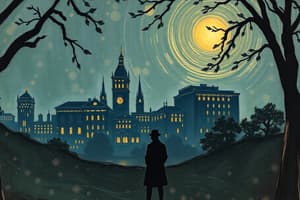Podcast
Questions and Answers
What was The Harlem Renaissance?
What was The Harlem Renaissance?
- A political organization for African-American rights.
- A movement in the 1920s and 1930s that introduced African-American voices into mainstream culture. (correct)
- A music style that originated in the South.
- A civil rights movement in the 1960s.
Who was W.E.B. Du Bois?
Who was W.E.B. Du Bois?
A civil rights spokesman and key figure in the Harlem Renaissance.
What significant work did Alain Locke write?
What significant work did Alain Locke write?
The New Negro
What is Zora Neale Hurston's most famous work?
What is Zora Neale Hurston's most famous work?
Who is considered the most celebrated Harlem Renaissance poet besides Langston Hughes?
Who is considered the most celebrated Harlem Renaissance poet besides Langston Hughes?
In what poem does Langston Hughes discuss the dream of equality?
In what poem does Langston Hughes discuss the dream of equality?
Match the following authors with their notable works:
Match the following authors with their notable works:
What issues does Claude McKay's poem 'America' address?
What issues does Claude McKay's poem 'America' address?
Flashcards are hidden until you start studying
Study Notes
The Harlem Renaissance
- A cultural movement during the 1920s and 1930s that showcased African-American artists and writers.
- Influenced by the migration of African-Americans to northern cities and the popularity of jazz music known as the Jazz Age.
- Marked the first significant concentration of black voices addressing the experience of being a minority in America.
- Prominent figures include W.E.B. Du Bois, Alain Locke, Zora Neale Hurston, Countee Cullen, Langston Hughes, and Claude McKay.
W.E.B. Du Bois
- An influential civil rights spokesperson for over 30 years.
- Authored "The Souls of Black Folk," a work that inspired 1960s black consciousness and activism.
- Co-founder of the National Association for the Advancement of Colored People (NAACP).
- Served as the editor for the NAACP's magazine, "The Crisis."
Alain Locke
- Authored "The New Negro," considered a pivotal work of the Harlem Renaissance.
- The book features a collection of essays and stories by diverse black writers, highlighting their insights and experiences.
Zora Neale Hurston
- A versatile writer known for her poems, plays, and novels, with "Their Eyes Were Watching God" as her most famous work.
- The novel explores gender and race issues through the perspective of a mixed-race woman in the South.
Countee Cullen
- A prominent poet of the Harlem Renaissance, alongside Langston Hughes.
- His poem "Heritage" explores the connection of African Americans to their African roots and culture.
Langston Hughes
- Celebrated as one of the leading poets of the Harlem Renaissance, noted for capturing the African American experience.
- "Harlem" reflects on the dream of equality and warns of the consequences of its unfulfillment for all races.
- "I, Too, Sing America" asserts his place in the American narrative despite racial discrimination.
Claude McKay
- A Jamaican-American writer and poet whose work addressed the challenges faced by black immigrants.
- "America" reflects a love-hate relationship with the nation, while "If We Must Die" calls for resistance during racial violence and advocates for the empowerment of African Americans.
Studying That Suits You
Use AI to generate personalized quizzes and flashcards to suit your learning preferences.




